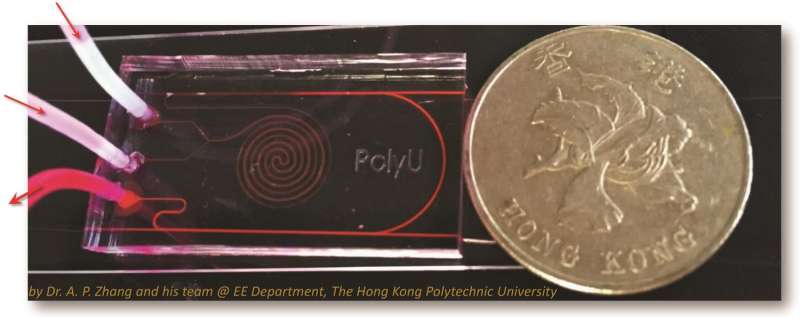Fiber optic biosensor-integrated microfluidic chip to detect glucose levels

Insulin deficiency and hyperglycemia are two well-known culprits behind diabetes, both of which are reflected in blood glucose concentrations. Now, researchers are working to create ultrasensitive lab-on-a-chip devices to quickly measure glucose concentrations with the goal of developing device for early diagnosis and prevent of diabetes
A team of researchers from The Hong Kong Polytechnic University and Zhejiang University in China report integrating fiber optic glucose sensors into a microfluidic chip to create portable, high-performance, low-cost devices for measuring glucose levels. In a paper published this week in the journal Biomedical Optics Express, from The Optical Society (OSA).
'Today, photonic approaches are recognized as the most promising techniques for ultrasensitive sensing," said Dr. A. Ping Zhang, associate professor, Department of Electrical Engineering, The Hong Kong Polytechnic University. "In particular, the synergistic integration of photonic sensing and microfluidics led to the state-of-the-art technology known as optofluidics for biological and chemical analysis."
One reason microfluidic chip technology is so appealing is that it provides a tiny platform to integrate sensors with functional components, such as microfluidic mixers, in order to achieve a lab-on-a-chip analysis system for fast and reliable results.
While electrochemical glucose biosensors can be integrated into microfluidic channels to develop easy-to-handle, low-cost, and portable microfluidic chips, electroactive interference problems often appear in electrochemical sensors. But fiber optic sensors offer a solution to this issue, thanks to their immunity to electromagnetic interference.
By combining a new fiber optic biosensor with a microfluidic chip, Zhang and colleagues created an interference-free optofluidic device for ultrasensitive detection of glucose levels.
Their method involves fabricating an optical fiber long-period grating (LPG) with a period of 390 microns within a small-diameter optical fiber with a cladding diameter of 80 microns, he explained. Such fiber optic devices induce strong co-directional mode coupling through a resonant scattering process. And the resulting central wavelength is very sensitive to changes of the refractive index (RI) of the surrounding media via the evanescent field of optical fiber cladding mode.
"To transform the fiber optic RI sensor into a glucose sensor, the team selected glucose oxidase as a sensing material that would react with glucose in solution. To support the sensing film and magnify RI change, a pH-responsive multilayer film of polyethylenimine (PEI) and polyacrylic acid (PAA) is deposited on the side surface of the LPG sensor before immobilization of the sensing film," Zhang noted.
The PEI/PAA multilayer film surveils the oxidation of glucose with the gluclose oxidase catalyst and responds to the reaction via swelling or contracting," he added.
"Experimental results revealed that the new fiber optic sensor is very sensitive on its own and can detect glucose oxidase concentrations as low as 1 nM (10-9 molarity)," he said. "But, after integration into the microfluidic chip, the sensor's performance was remarkably further improved in terms of detection range and response time."
"Also, notably, no significant loss of biomolecular activity was observed during the experiments, which implies that our layer-by-layer self-assembly technique renders a robust electrostatic absorption of glucose oxidase within the sensing film,"Zhang said.
"The team's work is a significant step toward developing optofluidic devices for the early diagnosis and prevention of diabetes," he said.
In terms of applications, the optofluidic device enables detection of glucose in solution "requiring only a tiny droplet of sweat. This makes it an extremely appealing technology to develop for early diagnosis of diabetes via monitoring glucose content within sweat," Zhang said.
Their ultimate goal is to develop multifunctional "lab-on-a-chip devices" through the integration of photonics, microfluidics, and functional materials onto a small chip. Such a technology will enable a broad range of research and development in biomedical diagnostics, environmental monitoring and even aid drug discovery," he noted.
More information: Ming-jie Yin et al, Optical fiber LPG biosensor integrated microfluidic chip for ultrasensitive glucose detection, Biomedical Optics Express (2016). DOI: 10.1364/BOE.7.002067
Journal information: Biomedical Optics Express
Provided by Optical Society of America



















